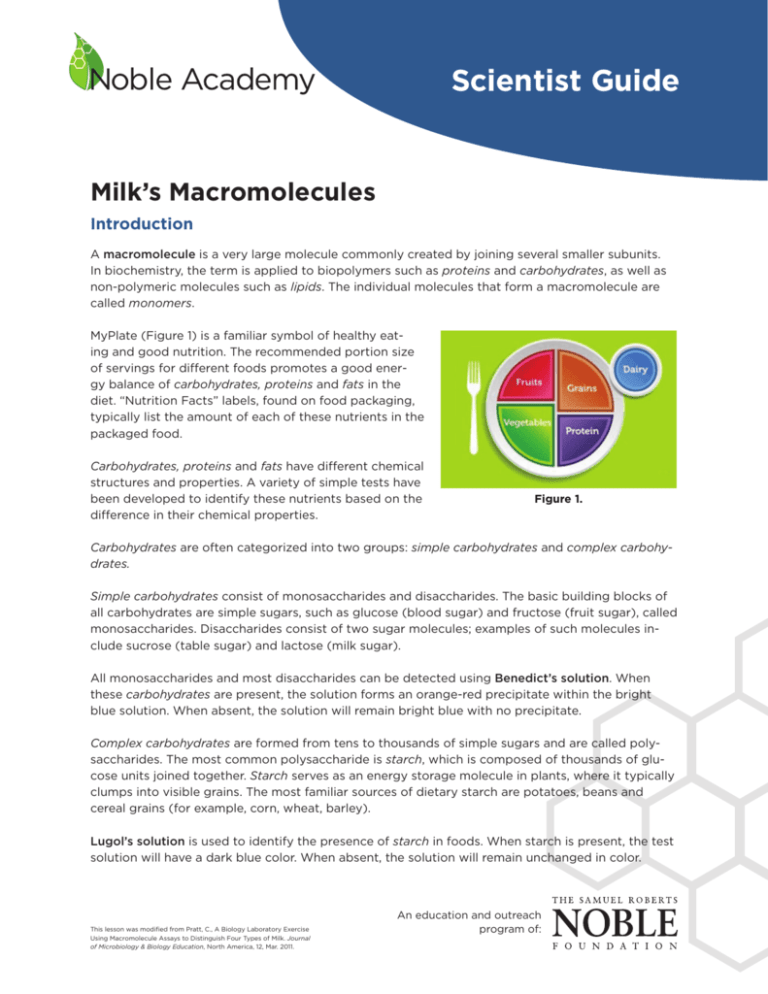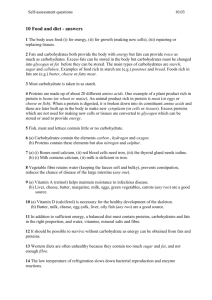Milk's Macromolecules Lesson Plan
advertisement

Scientist Guide Milk’s Macromolecules Introduction A macromolecule is a very large molecule commonly created by joining several smaller subunits. In biochemistry, the term is applied to biopolymers such as proteins and carbohydrates, as well as non-polymeric molecules such as lipids. The individual molecules that form a macromolecule are called monomers. MyPlate (Figure 1) is a familiar symbol of healthy eating and good nutrition. The recommended portion size of servings for different foods promotes a good energy balance of carbohydrates, proteins and fats in the diet. “Nutrition Facts” labels, found on food packaging, typically list the amount of each of these nutrients in the packaged food. Carbohydrates, proteins and fats have different chemical structures and properties. A variety of simple tests have been developed to identify these nutrients based on the difference in their chemical properties. Figure 1. Carbohydrates are often categorized into two groups: simple carbohydrates and complex carbohydrates. Simple carbohydrates consist of monosaccharides and disaccharides. The basic building blocks of all carbohydrates are simple sugars, such as glucose (blood sugar) and fructose (fruit sugar), called monosaccharides. Disaccharides consist of two sugar molecules; examples of such molecules include sucrose (table sugar) and lactose (milk sugar). All monosaccharides and most disaccharides can be detected using Benedict’s solution. When these carbohydrates are present, the solution forms an orange-red precipitate within the bright blue solution. When absent, the solution will remain bright blue with no precipitate. Complex carbohydrates are formed from tens to thousands of simple sugars and are called polysaccharides. The most common polysaccharide is starch, which is composed of thousands of glucose units joined together. Starch serves as an energy storage molecule in plants, where it typically clumps into visible grains. The most familiar sources of dietary starch are potatoes, beans and cereal grains (for example, corn, wheat, barley). Lugol’s solution is used to identify the presence of starch in foods. When starch is present, the test solution will have a dark blue color. When absent, the solution will remain unchanged in color. This lesson was modified from Pratt, C., A Biology Laboratory Exercise Using Macromolecule Assays to Distinguish Four Types of Milk. Journal of Microbiology & Biology Education, North America, 12, Mar. 2011. An education and outreach program of: Proteins are large natural polymers composed of amino acids joined together in chain-like fashion via peptide linkages. Because of these linkages, proteins can take many different forms. Polypeptide chains can fold up on themselves to form spherically shaped globular proteins, such as enzymes, or they can aggregate to form protein fibers, such as collagen. Examples of food proteins include albumin (egg white) and casein (milk). Proteins can be detected in food by using the biuret test. When proteins are present, the solution will have a lavender or purple color. When absent, the solution will remain unchanged in color. Fats and oils are members of a biological class of compounds called lipids. Lipids are classified on a simple physical property: they are insoluble (i.e., cannot dissolve) in water. This property makes them different from carbohydrates and proteins which generally dissolve in water. The Sudan IV test is a classic test for identifying lipids; it is used as a “fat stain” to identify lipids in foods, seeds and animal tissue. Activity Overview In this activity, you will identify the macromolecules present in three unlabeled types of milk (e.g., skim milk, whole milk and soy milk). From the characteristics you discover and by reviewing nutrition labels for each of the milk samples, you will identify which is skim milk, which is whole milk and which is soy milk. Materials • • • • • • • • Sudan IV stain Benedict’s solution Lugol’s solution Water (H2O, distilled or deionized) Filter paper Petri dish Water bath Vegetable oil • • • • • • • 6 test tubes Corks for test tubes Test tube rack Test tube clamp Wash bottle Milk (whole, skim, soy) Pipettes Safety Precautions • Avoid contact of all chemicals with eyes and skin. Wear safety glasses, lab coat and gloves when performing the experiment. o Benedict’s solution is mildly toxic by ingestion and a skin and body tissue irritant. o Lugol’s solution is an eye and skin irritant; it will stain skin and clothing. • Do not taste or ingest any materials in the laboratory. • Do not eat, drink or chew gum while in the laboratory. • Wash hands thoroughly with soap and water before leaving the laboratory. An education and outreach program of: Procedure Step 1: Lipid detection. • Using a pencil, label a piece of filter paper with your initials and with the following: A, B, C, oil and H2O. • Using a pipette, place two drops of each unknown milk sample (A, B and C), vegetable oil (positive control) and H2O (negative control) next to the labels on your filter paper and allow to air-dry. • When dry, place the filter paper in a petri dish containing Sudan IV solution. • Stain the filter paper for 1 minute. • Using forceps, remove the filter paper, hold the paper over the rinsing dish and rinse the filter paper with water, collecting the runoff in the dish. • Place the filter paper on your table and allow it to air-dry. • Observe the results, and record your data on your scientific data sheet. Step 2: Simple sugar detection. • Add 1 mL (20 drops) of Benedict’s solution to one set of unknown milk samples (A, B and C) in test tubes. • Place a cork in each of the tubes. • Gently swirl the tube to mix the solutions. • Carefully place the tubes in a 90° C water bath. • Heat the samples for 5 minutes. • Carefully remove the tubes using a test tube clamp, and place them in your test tube rack. (Caution: do not touch the tubes with your hands; they will be hot.) • Observe the results, and record your data on your scientific data sheet. Step 3: Starch detection. • • • • Add 5 drops of Lugol’s solution to one set of unknown milk samples (A, B and C) in test tubes. Place a cork in each of the tubes. Gently swirl the tube to mix the solutions. Observe the results, and record your data on your scientific data sheet. Step 4: Identifying the unknown milk samples. • Using the provided nutrition facts labels for skim milk, whole milk and soy milk, compare your data with the labels and determine which sample, A, B or C, was skim milk, whole milk or soy milk. (Hint: soy milk is derived from soybeans that are produced by soybean plants.) An education and outreach program of: Scientific Data Sheet Milk’s Macromolecules Classification Test Sample Tested Sudan IV Test Benedict’s Test A B C An education and outreach program of: Lugol’s Test Scientific Worksheet Milk’s Macromolecules Using the nutrition facts labels below and your data, predict which substance tested (A, B or C) was skim milk, whole milk or soy milk. Skim Milk Whole Milk Sample A: Sample B: Sample C: An education and outreach program of: Soy Milk Student Worksheet Milk’s Macromolecules Follow-up Name 1. Sudan IV detects the presence of which macromolecule? Proteins Carbohydrates DNA Lipids 2. The most common polysaccharide is? Glycogen Glucose Starch Lactose 3. Benedict’s solution is used to detect which macromolecule? Proteins Carbohydrates DNA Lipids 4. Proteins are made of what type of acids? 5. Lipids are soluble in water? True False An education and outreach program of: Teacher Resource Milk’s Macromolecules Follow-up Name 1. What is the name of the reagent that is used to detect lipids? 2. Simple sugars are the basic building blocks of which macromolecule? 3. Amino acids are the building blocks of which macromolecule? 4. Lugol’s solution is used to detect what type of macromolecule? 5. What is the name of the reagent that is used to detect starch? An education and outreach program of: Careers in Agriculture An education and outreach program of:






